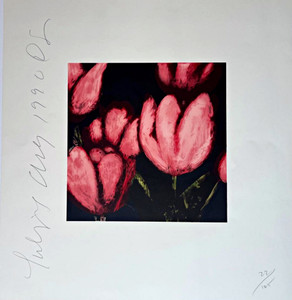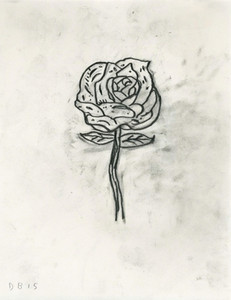
Donald Sultan
Yellow Roses, 1992
Screenprint in colors on wove paper
Pencil signed, titled, dated and numbered by Donald Sultan on the front
Frame Included
This work is floated and framed in its original hand made wood frame with acrylic glazing
Measurements:
Frame:
25 x 24 x 1.5 inches
Print:
23 x 22 inches
About Donald Sultan:
Donald Sultan (b. 1951 Asheville, NC) is an artist who rose to prominence in the late 1970s as part of the “New Image” movement. Sultan has challenged the boundaries between painting and sculpture throughout his career. Using industrial materials such as roofing tar, aluminum, linoleum and enamel, Sultan layers, gouges, sands and constructs his paintings—sumptuous, richly textured compositions often made of the same materials as the rooms in which they are displayed. Intrigued by contrasts, he explores dichotomies of beauty and roughness, nature and artificiality, and realism and abstraction. Weighty and structured, Sultan’s works are simultaneously abstract and representational: his imagery is immediately recognizable—flowers, daily objects, idle factories—but ultimately reduced to simple geometric and organic shapes. As Sultan says, “I try to pare down the images to their essence, and capture the fleeting aspect of reality by pitting the gesture against the geometric—the gesture being the fluidity of the human against the geometry of the object.”
Sultan’s early experiences building theatre sets at school, working in his father’s tire company in Asheville, and later in construction as a young artist in New York had a profound influence on his artistic development. These various lines of work led to an interest in industrial reproduction, heavy materials, and a practice of painting on floors and walls, à la Jackson Pollock. Sultan’s works, constructed horizontally, denote a purposely flat quality that borrows the synthetic flatness of stage sets while also utilizing the monumental weightiness of industrial materials—which harkens back to Asheville’s strong roots in manufacturing.
Interested in the artifice of nature as it is sold and packaged within a consumerist society, a major theme within Sultan’s work is studying the representation of an object or idea—how a flower, a factory, or a fruit is consumed in the Zeitgeist of the twentieth and twenty-first centuries. In the 1980s, Sultan began depicting lemons in the style of traditional still lifes. The blinding brightness of the yellow against the pitch black hue of the roofing tar he used as background make Sultan’s interpretations of these fruits hard to look at, while deferring monumental dignity to the common household good. The contrast of these natural organic shapes against the industrial materials and grid format has led Sultan to describe these works as pieces with “heavy structure, holding fragile meaning.” Playing with the dichotomy of meaning and material, perception and reality, the Lemon works began Sultan’s longstanding interest in depicting how an object is looked at, rather than the object itself.
His 1990s series on dominos and dice continue this reflection on the still life—the ultimate, slow, and concentrated gaze upon an object. A style entrenched in repetition and tradition, the repertoire of this style is ultimately limited, but the combinations endless. In his compositions of back dots and mathematically endless arrangements of dominoes, Sultan creates a visual metaphor for the limitations and possibilities of the still life tradition, and the liberties allowed within its set parameter.
The artist’s heavy use of industrial materials in the late twentieth century naturally led to his famous series of “catastrophic” paintings in the 1980s and 1990s. These industrial landscapes, titled the Disaster Paintings, illustrate the fragility of robust man-made structures, such as industrial plants and train cars, when faced with catastrophic events. This series was exhibited across the United States in a traveling exhibition in 2016 through 2018. The exhibition originated at the Lowe Art Museum at University of Miami and then traveled to the Museum of Modern Art, Fort Worth; Smithsonian American Art Museum, Washington, DC; North Carolina Museum of Art, Raleigh; and Sheldon Museum of Art, Lincoln.
In recent years, Sultan has pursued his interest in disrupting the established gaze cast upon everyday objects. His recent depictions of tulips, poppies, mimosas and camellias continue to interrogate how these flowers have been manipulated in art history—and this interrogation is aimed to destabilize a wider culture of visual status quo.
Sultan studied at the University of North Carolina, Chapel Hill and later received his MFA from the School of the Art Institute of Chicago. He lives and works in New York, NY.
His first solo exhibition was mounted in 1977 at Artists Space in New York. He has since exhibited worldwide in landmark solo and group exhibitions. In 2016, a major solo exhibition of Sultan’s Disaster Paintings began a two-year tour of five American museums through 2018. Organized by Dr. Marla Price, the exhibition originated at the Lowe Art Museum at the University of Miami, FL travelling to the Museum of Modern Art, Fort Worth, TX; Smithsonian American Art Museum, Washington, DC; North Carolina Museum of Art, Raleigh, NC; and Sheldon Museum of Art, Lincoln, NE. In 2017, Sultan was featured in the British Museum's The American Dream: Pop to the Present; featuring fellow groundbreaking, American printmakers working from the 1960s onwards, the exhibition travelled to the Fondation Custodia in Paris, France in 2018 before moving onto CaixaForum Madrid, Barcelona, and Zaragoza in 2020 and 2021.
Sultan has also exhibited in solo and group shows at the Cameron Art Museum, NC (2022); Huntington Museum of Art, WV (2021); Parrish Art Museum, NY (2020); Taubman Museum of Art, VA (2019); Sellars Gallery at Brenau University, GA (2018); British Museum, London (2017); Royal Academy of Arts, London (2017); Contemporary Arts Center, Cincinnati, OH (2009); Corcoran Gallery of Art, Washington, DC (2000); Memphis Brooks Museum of Art, TN (2000); Gotlands KonstMuseum, Sweden (1996); Nationalgalerie, Berlin (1993); Solomon R. Guggenheim Museum, NY (1988); Museum of Modern Art, NY (1988); Museum of Contemporary Art, Chicago, IL (1987); Museum of Contemporary Art, Los Angeles, CA (1987); Musée d’art Contemporain, Montreal (1984); and the Whitney Museum of American Art, NY (1979), among others.
His work is included in the collections of the Addison Gallery of American Art, MA; Albright-Knox Art Gallery, NY; Art Institute of Chicago, IL; Bank of America Collection; British Museum, London; Cleveland Art Museum, OH; Denver Art Museum, CO; Detroit Institute of Arts, MI; Fogg Art Museum at Harvard University, MA; High Museum of Art, GA; Hirshhorn Museum and Sculpture Garden, Washington, DC; Ludwig Museum, Budapest; Metropolitan Museum of Art, NY; Modern Art Museum of Fort Worth, TX; Museum of Contemporary Art, Tokyo; Museum of Contemporary Art San Diego, CA; Museum of Fine Arts, Boston, MA; Museum of Fine Arts, Houston, TX; Museum of Modern Art, NY; National Gallery of Australia, Canberra; Nelson-Atkins Museum, MO; Pennsylvania Academy of the Fine Arts, PA; San Francisco Museum of Modern Art, CA; Singapore Museum of Art, Singapore; Solomon R. Guggenheim Museum, NY; St. Louis Art Museum, MO; Tate Gallery, London; Toledo Museum of Art, OH; Walker Art Center, MN; and the Whitney Museum of American Art, NY.
Courtesy of Ryan Lee Gallery








